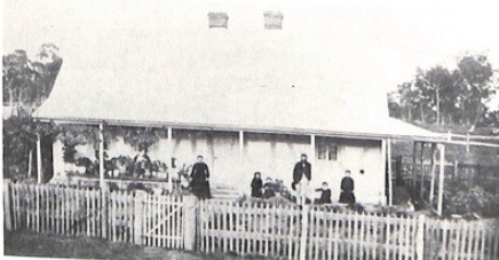This Page forms part of the overall Zebra-ProjectBy clicking on the following Link a list of all Zebra-Project tabbed pages will be displayed. |
Lothar BRASSELIEBELT & KLAEBSCH home |
To return to: Lothar Brasse summary
Summary
The family names mentioned in this article
 Photo from the 'John MUELLER Photo Collection'.
Photo from the 'John MUELLER Photo Collection'.
 LIEBELT Family History page 56
LIEBELT Family History page 56
In 1975 this Fachwerk / half-timbered home was described by historian Alan WITTWER in the 'LIEBELT Family History' book as 'the original home of timber frame construction still stands and is in good condition'. For more information
Timber framing of above home
 Hahndorf Survey Volume 1 pge 177
Hahndorf Survey Volume 1 pge 177
Aim of this Article
Table of Contents
1. Author's Note
Author's Note
This house was situated about 240 m off the LIEBELT Road on the right, just prior to the intersection with Strathalbyn Road at Biggs FLAT.
Where is it?
This ' Liebelt House' was located in the former 'Friedrichstadt', and the current Biggs Flat, and the property is now known as ‘Jurlique Farm' The main entrance is off Liebelt Road, and it also abuts Kangaroo Reef and Snelling Road. The property is 4 kms from Mylor and 6.5kms from Hahndorf. It was recorded in the 1974/75 'Hahndorf Survey' and is now demolished.
Construction method by Lothar Brasse, B.Architecture & Heritage Consultant, September 2022.
Dimensions
The footprint of this simple cottage was 10.85m x 5.36m that is, almost exactly 2 squares next to each other measuring 5.36m x 5.36 each suggesting that its builder knew about good design principles and geometric proportions. A 1 m wide door was located slightly off centre leading to the central brick-paved hall and kitchen ahead. This was a common German House plan with slight variations to those built at other Friedrichstadt locations, as well as all four of the 'Paechtown houses' and 'Wieth'’s house (also known as the 'Hoffmann house') on what is now the Beerenberg property.
Walls
Wall construction was Fachwerk where every (approx. 150 x 150) square piece of redgum was identified using carved Roman numerals. Thus, every post, nogging and brace had an identification number to assist with on-site assembly. All timber connections were achieved using master-crafted joints which were then tightened by Stringy Bark dowels.
Braces were unique
This 'Liebelt House' had the most exuberant timber display in Australia. Although a relatively small house, it has 4 braces on the principal façade. The less than 1m2 spaces between the timbers were filled with brick on the gable ends and lime washed mud on the long elevations. The plaster was applied to straw woven between sharpened timber staves which in turn were wedged between the lower groove and upper chiselled or augered holes. Roof consisted of a series of trusses spaced approx. 600 (2 feet) apart securely braced and battened to take timber shingles. The corrugated iron was a later addition.
Lehmwickel
Boards wrapped in straw and clay (known as Lehmwickel literally mud-wraps) were wedged between the bottom chords of the roof trusses and once the final layer of chaff/mud mix was applied over the whole area formed a sturdy attic floor. The attic was an extension of the floor plan where goods were stored, cottage industries were carried out and ‘that's where the boys slept.' Access to the attic was via an internal steep stair next to the entry door. In other similar houses an external gable stair was also used. A return verandah seemed to have been part of the original construction. Windows and doors were expertly made by a local joiner. Hearths and chimneys were soft-fired clay bricks. A later lean-to addition at the back incorporated a large stone fireplace for the kitchen and dining areas as well as a step-down cellar.
LIEBELT Family History page 56
The SECOND SON - His first child, second child.
Johann Friedrich Wilhelm LIEBELT & Johanne Wilhelmine KLAEBSCH
 Johann Friedrich Wilhelm was born at Friedrichstadt on October 10, 1851. He was married in St Michael's Church, by Pastor STREMPEL on April 20, 1876, to Johanne Wilhelmine KLAEBSCH, who ws born on May t, 1853. Wilhelmine's parents were Johann Wilhelm KLAEBSCH & his wife Johanne Friedericke born BÜTTNER who came from the village of Bentnitz. It seems likely that the KLAEBSCH's emigrated in the early 1850's; the family settled in Salem just south of Callington.
Johann Friedrich Wilhelm was born at Friedrichstadt on October 10, 1851. He was married in St Michael's Church, by Pastor STREMPEL on April 20, 1876, to Johanne Wilhelmine KLAEBSCH, who ws born on May t, 1853. Wilhelmine's parents were Johann Wilhelm KLAEBSCH & his wife Johanne Friedericke born BÜTTNER who came from the village of Bentnitz. It seems likely that the KLAEBSCH's emigrated in the early 1850's; the family settled in Salem just south of Callington.
Wilhelm & Wilhelmine settled in parts of sections 3901 & 3902 in the Hundred of Kuitpo - Thea area later became known as Bigg's Flat. Their original home of timber frame construction still stands and is in good condition. Wilhelm was a farmer acquiring a number of additional sections of land over the years [including section 410]
For a number of years Wilhelm served as a councillor on the District Council of Echunga. In later years Wilhelm refused to work on his birthday - he went fishing in the Onkaparinga River instead.
Wilhelm died on December 12, 1925; his wife passed away on August 20, 1933. Both are buried in the Hahndorf Cemetery where their graves are marked by a tombstone.


